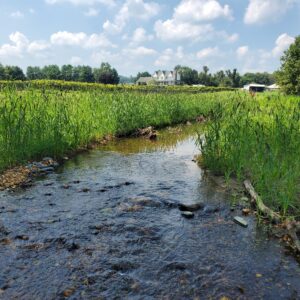
A mitigation bank is a wetland, stream, or other aquatic resource area that has been restored, established, enhanced, or in certain circumstances preserved for the purpose of providing compensation for unavoidable impacts to aquatic resources permitted under Section 404 or a similar state or local wetland regulation.
A mitigation bank may be created when a government agency, corporation, nonprofit organization, or other entity undertakes these activities under a formal agreement with a regulatory agency. Mitigation banks have four distinct components:
- The Bank Site: the physical acreage restored, established, enhanced, or preserved;
- The Bank Instrument: the formal agreement between the bank owners and regulators establishing liability, performance standards, management and monitoring requirements, and the terms of bank credit approval;
- The Interagency Review Team: the inter-agency team that provides regulatory review, approval, and oversight of the bank; and
- The Service Area: the geographic area in which permitted impacts can be compensated for at a given bank.
The value of a bank is defined in “compensatory mitigation credits.” A bank’s instrument identifies the number of credits available for sale and requires the use of ecological assessment techniques to certify that those credits provide the required ecological functions. Although most mitigation banks are designed to compensate only for impacts to various wetland types, some banks have been developed to compensate specifically for impacts to streams (i.e., stream mitigation banks).
Mitigation banks are a form of “third-party” compensatory mitigation, in which the responsibility for compensatory mitigation implementation and success is assumed by a party other than the permittee. This transfer of liability has been a very attractive feature for Section 404 permit-holders, who would otherwise be responsible for the design, construction, monitoring, ecological success, and long-term protection of the site.
Mitigation banking has a number of advantages over traditional permittee-responsible compensatory mitigation because of the ability of mitigation banking programs to:
- Reduce uncertainty over whether the compensatory mitigation will be successful in offsetting project impacts;
- Assemble and apply extensive financial resources, planning, and scientific expertise not always available to many permittee-responsible compensatory mitigation proposals;
- Reduce permit processing times and provide more cost-effective compensatory mitigation opportunities; and
- Enable the efficient use of limited agency resources in the review and compliance monitoring of compensatory mitigation projects because of consolidation.
Knowledge Credit:
- www.epa.gov/cwa-404/mitigation-banking-factsheet
- http://www.nab.usace.army.mil/Missions/RegulatoryA/Mitigation/


